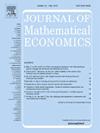Critical capital stock in a continuous-time growth model with a convex-concave production function
IF 0.7
4区 经济学
Q3 ECONOMICS
引用次数: 0
Abstract
A nonconcave growth model may exhibit multiple optimal steady states, with a critical capital stock serving as a threshold. Optimal capital paths originating from stock levels below (above) this threshold converge to lower (higher) optimal steady states. The presence of a critical capital stock elucidates the phenomenon of history-dependent development and carries implications for achieving sustainable development. In a continuous-time model featuring a convex-concave production function, we demonstrate that: (a) the critical capital stock is continuous and strictly increasing in the discount rate; (b) its lower bound is the zero capital stock, while the upper bound lies between the stock levels associated with maximum marginal productivity and maximum average productivity; (c) at the upper bound, the critical capital stock coincides with the higher optimal steady state; and (d) the upper bound approaches the capital stock corresponding to maximum average productivity as the intertemporal elasticity of substitution approaches infinity, and converges to that of maximum marginal productivity as the intertemporal elasticity of substitution tends to 0.
具有凸凹生产函数的连续时间增长模型的临界资本存量
一个非凹增长模型可以表现出多个最优稳态,以临界资本存量作为阈值。从低于(高于)这个阈值的库存水平开始的最优资本路径收敛于较低(较高)的最优稳定状态。关键资本存量的存在阐明了依赖历史的发展现象,并对实现可持续发展产生影响。在一个具有凸凹生产函数的连续时间模型中,我们证明了:(a)临界资本存量是连续的,并且贴现率严格增加;(b)其下界为零资本存量,上界介于与最大边际生产率和最大平均生产率相关的存量水平之间;(c)在上界处,临界资本存量与较高最优稳态重合;(d)当替代跨期弹性趋于无穷时,上界趋近于最大平均生产率对应的资本存量,当替代跨期弹性趋于0时,上界收敛于最大边际生产率对应的资本存量。
本文章由计算机程序翻译,如有差异,请以英文原文为准。
求助全文
约1分钟内获得全文
求助全文
来源期刊

Journal of Mathematical Economics
管理科学-数学跨学科应用
CiteScore
1.70
自引率
7.70%
发文量
73
审稿时长
12.5 weeks
期刊介绍:
The primary objective of the Journal is to provide a forum for work in economic theory which expresses economic ideas using formal mathematical reasoning. For work to add to this primary objective, it is not sufficient that the mathematical reasoning be new and correct. The work must have real economic content. The economic ideas must be interesting and important. These ideas may pertain to any field of economics or any school of economic thought.
 求助内容:
求助内容: 应助结果提醒方式:
应助结果提醒方式:


